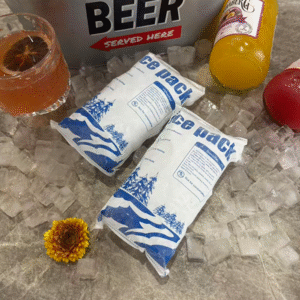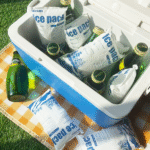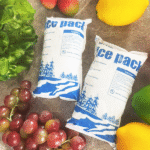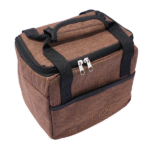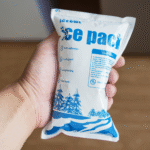Introducción
En la logística de la cadena de frío, bolitas de hielo seco y paquetes de hielo seco se han convertido en herramientas de refrigeración esenciales para mantener la integridad del producto desde el almacén hasta el destino.. Si está enviando vacunas, mariscos, o muestras de laboratorio, elegir la forma adecuada de hielo seco determina no sólo la estabilidad de la temperatura, sino también su eficiencia operativa y control de costos..
en esto 2025 guía, Aprenderá cómo seleccionar y aplicar soluciones de hielo seco que coincidan con sus objetivos logísticos., requisitos reglamentarios, y estándares de sostenibilidad.
-
El diferencias clave entre bolitas de hielo seco y bolsas de hielo seco
-
Casos de mejor uso a través de productos farmacéuticos, alimento, y sectores logísticos
-
Almacenamiento y seguridad prácticas para el manejo de hielo seco
-
2025 innovación mejorar la sostenibilidad de la cadena de frío
-
Cómo maximizar el rendimiento de refrigeración mientras reduce el desperdicio
¿Qué son los gránulos de hielo seco y cómo se utilizan en la logística de la cadena de frío??
Los gránulos de hielo seco son pequeños., Piezas cilíndricas de dióxido de carbono sólido. (Co₂) diseñado para rápido, enfriamiento directo. Debido a que se subliman (pasando directamente de sólido a gas), no dejan residuos líquidos., haciéndolos ideales para productos sensibles a la temperatura.
Se utilizan ampliamente en industrias donde mantener temperaturas ultrabajas es fundamental., incluido envío farmacéutico, muestras de biotecnología, y transporte de alimentos congelados.
¿Cómo funcionan en la práctica los gránulos de hielo seco??
Los gránulos de hielo seco absorben rápidamente la energía térmica, produciendo un enfriamiento intenso a -78,5°C (-109°F). Esta rápida caída de temperatura garantiza que los productos permanezcan congelados durante el transporte de larga distancia.. La pequeña superficie de los pellets permite una distribución uniforme dentro de cajas aisladas o contenedores de envío., ofrenda cobertura térmica constante.
Resumen comparativo: Pellets de hielo seco vs.. Otras opciones de enfriamiento
| Método de enfriamiento | Rango de temperatura | Duración | Aplicación ideal | Beneficio del mundo real |
|---|---|---|---|---|
| Pellets de hielo seco | -78.5°C | 24–48 horas | Envío ultrafrío | Sin residuos líquidos, control de temperatura preciso |
| Paquetes de hielo seco | -40°C a -60°C | 36–72 horas | Enfriamiento a medio plazo | Sublimación más lenta, reutilizable, colocación flexible |
| Paquetes de gel | 0° C a -20 ° C | 12–24 horas | Transporte de alimentos perecederos | Económico, reutilizable |
| Materiales de cambio de fase (PCM) | Personalizable | 24–96 horas | Kits biofarmacéuticos o de diagnóstico | Bandas de temperatura estables |
Consejos prácticos para utilizar gránulos de hielo seco
-
Para farmacéutica: Utilice gránulos de alta densidad en transportadores aislados al vacío para obtener la máxima eficiencia.
-
Para la comida: Coloque los gránulos uniformemente debajo y alrededor de los productos para evitar la descongelación parcial..
-
Para logística: Combine pellets con materiales de cambio de fase para envíos multizona extendidos.
Ejemplo: Un envío de vacunas que requiere una estabilidad de -70°C para 48 horas lograron resultados óptimos utilizando 5 kg de gránulos de hielo seco de 3 mm en un contenedor de EPS de alto rendimiento, reducir el riesgo de deterioro mediante 40%.
¿Cuándo debería utilizar bolsas de hielo seco en lugar de pellets??
Las bolsas de hielo seco son contenedores sellados llenos de nieve de CO₂ comprimida o suspensión de CO₂ congelada.. Están diseñados para proporcionar mayor duración de enfriamiento con menor liberación de vapor, haciéndolos ideales para envíos a temperatura media o sistemas logísticos reutilizables.
Ventajas de las bolsas de hielo seco en 2025 Operaciones de cadena de frío
-
Duración de enfriamiento extendida – Hasta 72 horas de temperatura estable.
-
Sin riesgo de contacto directo – Más seguro para los trabajadores que manipulan envíos grandes.
-
Diseño reutilizable – Reduce los residuos de embalaje y los costes operativos..
-
Tamaños personalizables – Colocar cajas aisladas, cajas, y palets fácilmente.
Diferencias clave entre los pellets y los paquetes de hielo seco
| Característica | Pellets de hielo seco | Paquetes de hielo seco | Lo que significa para ti |
|---|---|---|---|
| Velocidad de enfriamiento | muy rapido | Gradual | Elija pellets para congelar rápidamente; packs para refrigeración controlada |
| Reutilizabilidad | De un solo uso | Multiuso | Los paquetes son mejores para envíos recurrentes |
| Manejo | Requiere EPP | Más seguro de manejar | Las mochilas reducen la exposición al CO₂ |
| Costo | Menor por kg | Mayor por unidad | Depende de la frecuencia de envío |
Perspectiva del caso: Un exportador de productos del mar reemplazó el envío a base de pellets por bolsas de hielo seco reutilizables, reducir los residuos de envases 60% manteniendo una consistencia de -40°C durante 72 horas.
Cómo manipular y almacenar hielo seco de forma segura en sus operaciones de cadena de frío
El hielo seco ofrece importantes beneficios térmicos, pero exige un manejo adecuado. El almacenamiento o la ventilación inseguros pueden causar aumento de presión o riesgos de exposición al CO₂..
Pautas de almacenamiento
-
Guarde el hielo seco en áreas ventiladas, nunca en recipientes herméticos.
-
Mantenga los cuartos de almacenamiento entre -80°C y -20°C para una retención óptima.
-
Evite el contacto directo de la piel; siempre uso guantes aislados.
-
Rotar el inventario usando el primero en, primero en salir (FIFO) sistema.
Consejos de transporte
-
Usar contenedores aislados con orificios de ventilación para evitar la acumulación de CO₂.
-
Realice un seguimiento de las temperaturas internas mediante registradores de datos digitales o sensores de IoT.
-
Capacitar al personal en procedimientos de emergencia en caso de fugas de CO₂ o casos de congelación..
| Tipo de riesgo | Causa | Prevención | Impacto en ti |
|---|---|---|---|
| Acumulación de co₂ | Mala ventilación | Instalar extractores de aire | Previene riesgos para los trabajadores |
| Descongelación del producto | Aislamiento inadecuado | Utilice EPS o paneles de vacío | Reduce la pérdida de producto |
| Congelación | Contacto directo | Use guantes aislados | Garantiza la seguridad de los trabajadores |
Nota de seguridad: En 2025, la mayoría de las instalaciones logísticas están adoptando sensores de CO₂ inteligentes integrados con control de ventilación por IA para mantener el cumplimiento de la norma ISO. 23412 normas de seguridad de la cadena de frio.
Cómo maximizar la eficiencia del enfriamiento y reducir los costos en 2025
El hielo seco sigue siendo una solución rentable y sostenible cuando se aplica estratégicamente. Para reducir ambos desperdicio de energía y costo de materiales, Las empresas están integrando monitoreo inteligente de temperatura y sistemas de enfriamiento híbridos..
Estrategias de optimización
-
Utilice el formato correcto: Pellets para congelación instantánea; paquetes para un enfriamiento constante.
-
Envasado previo al enfriamiento: Reduce la tasa de sublimación hasta 15%.
-
Combinar con revestimientos aislados: Extiende la duración del enfriamiento entre un 20% y un 30%.
-
Monitorear la pérdida de sublimación: Utilice dispositivos de seguimiento inteligentes para optimizar los ciclos de reabastecimiento.
Datos de la industria (2025): Las empresas que implementan sistemas híbridos de bolsas de hielo seco informaron un 25% mejora en la consistencia de la temperatura y 18% reducción de costes de material de refrigeración.
Ángulo de sostenibilidad
Los actores modernos de la cadena de frío están adoptando Sistemas de recuperación de CO₂, Permitir que se produzca hielo seco a partir de emisiones capturadas, apoyando los objetivos de economía circular y la neutralidad de carbono..
2025 Tendencias en la tecnología de enfriamiento con hielo seco
El sector de la cadena de frío está evolucionando rápidamente, con la tecnología de hielo seco a la vanguardia de la innovación en logística sostenible.
Avances clave
-
Peletizadores automatizados: Produzca un tamaño de pellet consistente, reduciendo el desperdicio.
-
Hojas de hielo seco reutilizables: Combine la flexibilidad de los paquetes con el poder de enfriamiento de pellets.
-
Sensores de monitoreo inteligentes: Realice un seguimiento de los niveles de CO₂ y las tasas de sublimación en tiempo real.
-
Integración de envases de base biológica: Reducir los plásticos de un solo uso en las cajas térmicas.
Perspectivas de los mercados emergentes
-
Cadena de frío farmacéutica: creciendo en 7.3% Tocón, impulsado por envíos de medicamentos biológicos.
-
Entrega de alimentos de comercio electrónico: Aumentó 35% en 2025, que requieren soluciones de refrigeración de gama media.
-
Logística Sostenible: Encima 60% de los proveedores adoptan ahora sistemas de envases reutilizables.
Preguntas frecuentes
Q1: ¿Cuánto tiempo duran los gránulos de hielo seco en tránsito??
Típicamente, 24–48 horas, dependiendo de la calidad del aislamiento y de la temperatura exterior.
Q2: ¿Pueden las bolsas de hielo seco reemplazar las bolsas de hielo normales??
Sí, especialmente para envíos que requieren temperaturas inferiores a -40°C. Ofrecen un rendimiento más prolongado y sin residuos de agua..
Q3: ¿Es el hielo seco seguro para el transporte aéreo??
Sí, pero debe cumplir con Regulaciones de mercancías peligrosas de IATA (Sección 5.5.3), Requiere etiquetado y contenedores ventilados..
Q4: ¿Cómo sé cuánto hielo seco usar??
Por regla general, asignar 5–10 kg de hielo seco por envío de 24 horas por 100 litros de volumen aislado.
Q5: ¿Cuáles son las mejores alternativas ecológicas al hielo seco tradicional??
Pellets de bio-CO₂ y paquetes de cambio de fase reutilizables con cubiertas exteriores reciclables.
Resumen y recomendaciones
Los pellets de hielo seco y las bolsas de hielo seco desempeñan funciones distintas en la logística de la cadena de frío..
Los pellets destacan por su velocidad, aplicaciones ultrafrías, mientras que los paquetes entregan constantemente, enfriamiento reutilizable para duraciones prolongadas. La elección óptima depende de la sensibilidad de su producto., duración del transporte, y objetivos de sostenibilidad.
Control de llave
-
Usar bolitas de hielo seco para operaciones farmacéuticas o de congelación instantánea.
-
Elegir paquetes de hielo seco para reutilizable, entregas a media temperatura.
-
priorizar seguimiento inteligente y refrigeración híbrida para la rentabilidad.
-
Integrar Sistemas de recuperación de CO₂ para operaciones más ecológicas.
Siguientes pasos
-
Audite la configuración de su cadena de frío – Identificar las etapas de temperatura crítica.
-
Seleccione el formato de hielo adecuado basado en la duración y la sensibilidad.
-
Actualícese a contenedores inteligentes con control térmico digital.
-
Asóciese con proveedores certificados para una calidad constante del hielo seco.
Sugerencia de acción: Para necesidades de envío complejas, Pruebe tanto los pellets como los paquetes de hielo seco en condiciones controladas para determinar cuál ofrece la mejor relación costo-temperatura para su operación..
Acerca de Tempk
En Templ, Nos especializamos en soluciones avanzadas de control de temperatura y embalaje de cadena de frío que mantienen sus productos seguros desde el origen hasta el destino..
Nuestra experiencia cubre tecnología de hielo seco, cargadores aislados, y Monitoreo de temperatura basado en IoT—confiado por farmacéutica, alimento, y líderes en logística a nivel mundial.
Innovamos continuamente con materiales ecológicos y Métodos de producción eficientes en CO₂ para ayudar a su empresa a alcanzar los objetivos de rendimiento y sostenibilidad.
Llamado a la acción:
¿Quiere optimizar sus sistemas de refrigeración para 2025? Póngase en contacto con nuestros expertos para asesoramiento personalizado y análisis gratuito del rendimiento de la cadena de frío.






